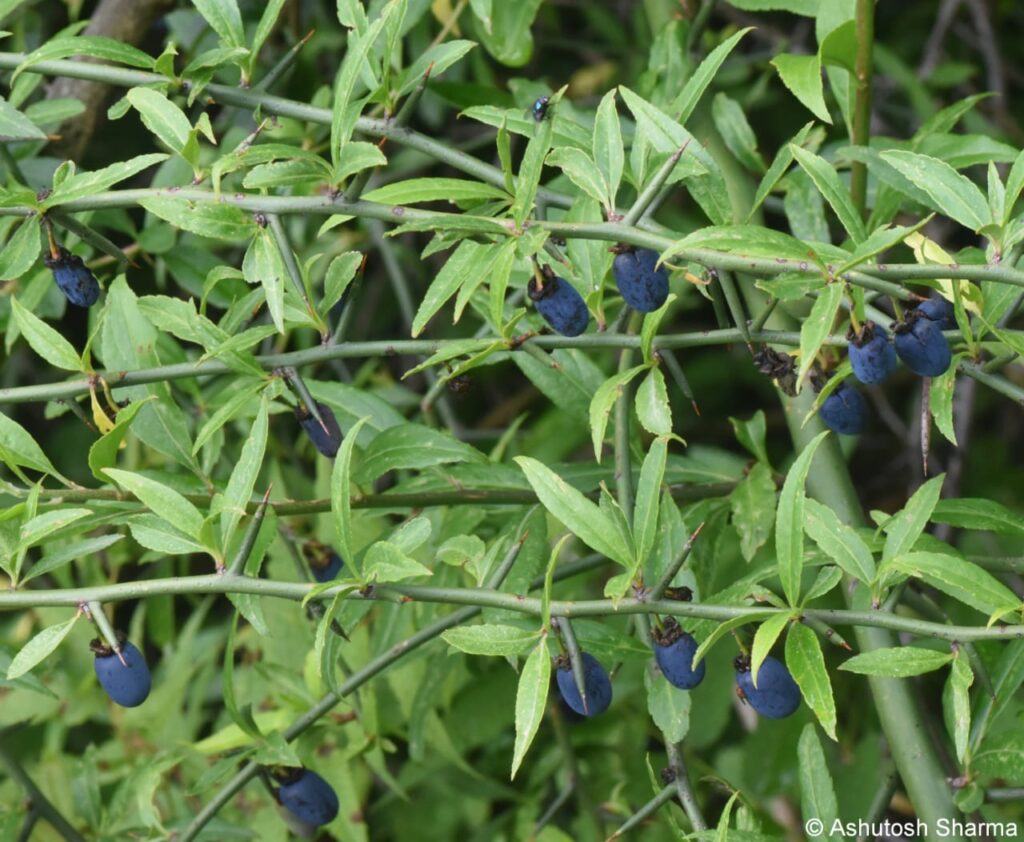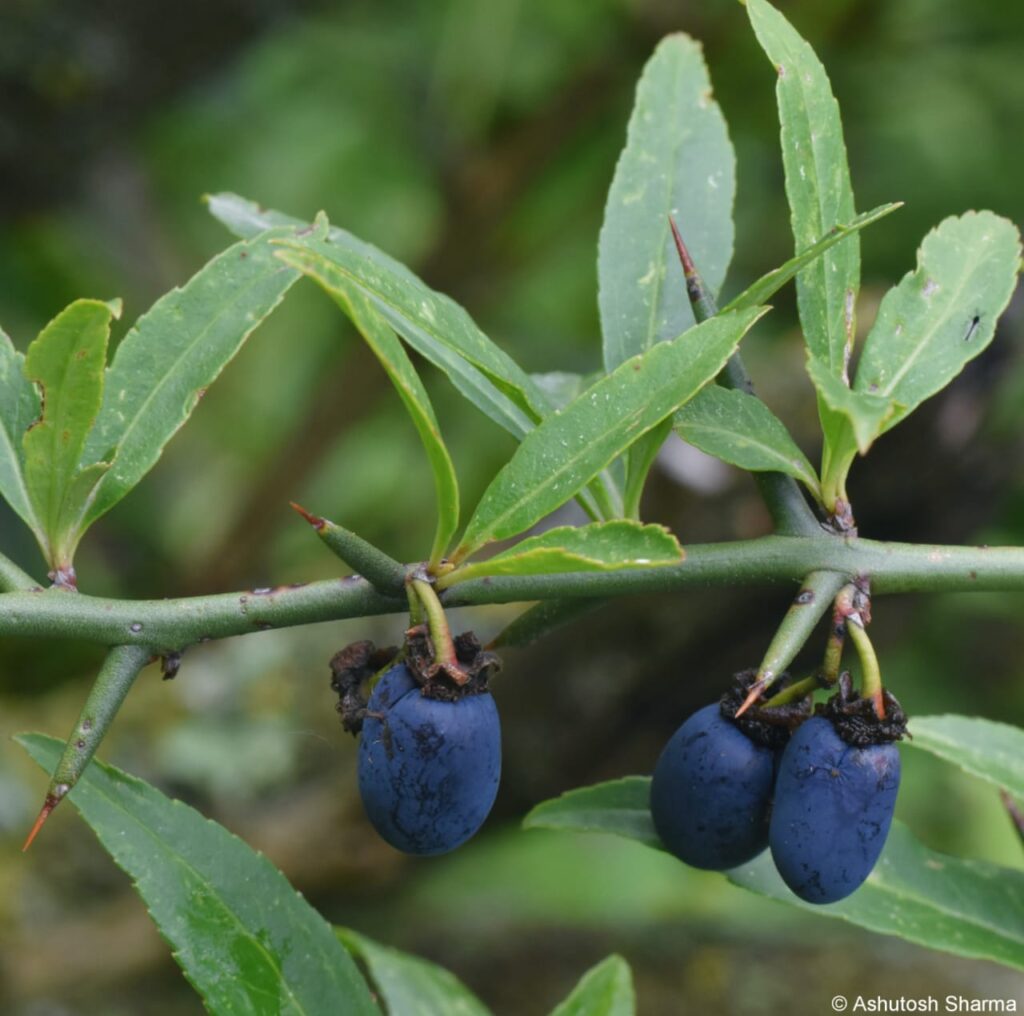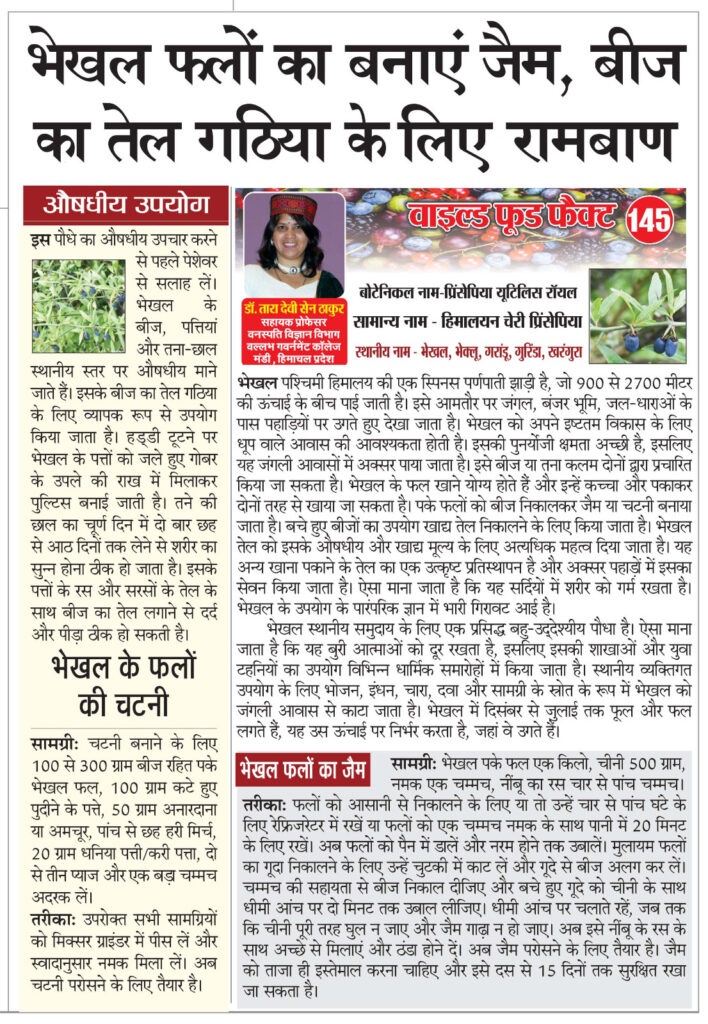Family: Rosaceae
Common name: Himalayan Cherry Prinsepia
Local name: Bhekal(भेखल), Bhaeklu, Garandu, Gurinda, Kharngura
Bhekal is a spinous deciduous shrub of Western Himalayas found growing between an altitudinal range of 900 to 2700m. It is commonly seen growing in forest, barren land, field margins, dry slopes, hillsides usually near spring or water-courses. Bhekal requires well-drained sunny habitat for its optimum growth, however it can also succeed in any moderately fertile light shady habitats. It has good regenerative capacity, so it is frequent in wild habitats. It can be propagated both by seeds or stem cuttings.

Bhekal fruits are edible and can be taken both raw and cooked. Ripe fruits are deseeded and made into jam or chutney. Left out seeds are utilized to extract the edible oil. Bhekal oil is highly valued for its medicinal and food value. It is an excellent replacement of other cooking oil and often consumed in hills. It is believed to keep the body warm in winters, However, traditional knowledge of utilizing Bhekhal has declined drastically
Bhekal is a well-known multipurpose plant for the local community due to its multifarious uses. It is supposed to keep evil spirits away, so its branches and young twigs are utilized in various religious ceremonies. They harvest it from wild habitat as a source of food, fuel, fodder, medicine and material for their local personal uses.
People sometimes also cultivate Bhekal for its easy access. Usually it is grown as a hedge or a soil binder.
Bhekal Plant:
Plant is sub-deciduous, dark green, spinous shrubs, up to 3.5m high.
Leaves alternate, simple, 2-3.5 cm long, elliptic or lanceolate, narrowed at both ends, acuminate, serrate, glabrous.

Flowers white, 5-12 mm across, in shorts, axillary racemes. Calyx cup shaped, persistent. Petals orbicular, shortly clawed.
Drupes are oblong-cylindric, fleshy, purple when ripe, 1-1.6cm long, 1-seeded.
Bhekal is in flowering and fruiting from December to July depending upon the altitudinal range where they grow. Its edible fruits and seeds can be collected in late summers for edible purposes as fruits and seeds are also responsible for propagation of this plant to a new habitat, so they need to be sustainably harvested either by keeping some fruits on the parent plant or by habitat rotation.
Edible uses:
Bhekal fruits are eaten both raw and cooked. Its seed oil is used in cooking to harness the rich medicinal value of this plant and to keep the body warm in winters. Fruits can be taken as jam or chutney.
Jam:
Ingredients:
Bhekhal ripe fruits ,1 kg; sugar, 500 g; salt, 1 teaspoon; lemon juice, 4-5 teaspoons.
Method:
For easy deseeding fruits either keep them in the refrigerator for 4 to 5 hours or put fruits with one teaspoon of salt in water for 20 minutes. Now transfer the fruits into the pan and boil till they are soft. Pinch soft fruits to remove its pulp and segregate seeds from pulp. Remove seeds with the help of a spoon and then boil left out pulp in low flame with sugar for two minutes. Keep stirring in a slow flame till sugar dissolves completely and jam becomes dense. Now mix it well with lemon juice and let it cool down. Now jam is ready to serve. Jam should be used fresh and can be preserved for 10 to 15 days.
Chutney:
Ingredients:
To prepare chutney, take 100 to 300 gm deseeded ripe Bhekhal fruits , 100 gm chopped mint leaves, 50 gm anardana or amchoor, 5-6 green chillies, 20 gm coriander leaves/ curry leaves, 2-3 onion, and 1 tablespoon amount ginger.
Method:
Grind all above ingredients in a mixer grinder and add salt according to taste. Now chutney is ready to serve.
Nutritional value:
Moisture content: 7.36%; Fat 34.24%; Crude fibre 14.57%; Total protein content 20.99%; Ash content 2.19%; Calorific value 475 k cal/100 g.
The seed kernel is rich in macro and micro nutrient composition, i.e., phosphorus, magnesium, calcium, sodium, iron, manganese, zinc, lead, cadmium. sodium (14.80 mg/100 g), iron (6.64 mg/100 g) and lead (0.51 mg/kg), iodine 93.80%; In oil major constituent is oleic acid (36.25%), linoleic acid (32.10%) and palmitic acid (18.90%) 1.
Seek Professional advice before treating this plant medicinally.
Medicinal uses:
Seeds, leaves and stem-bark of Bhekal are considered medicinal locally. Its seed oil is widely utilized for rheumatism. A poultice is prepared to cure bone fractures by mixing Bhekal leaves with ash of burnt cow-dung cake. Powdered stem-bark taken twice in a day for 6-8 days can cure body numbness. Seed oil if applied with its leaf juice and mustard oil can cure aches and pains.
Literature review reveals that Bhekal has a long history of traditional uses tocure burns, cuts, rheumatism, skin diseases, inflammation, arthritis, diarrhea, stomachache, leprosy, pains from over-fatigue and wounds.(2,3,4,5,6,7,8,).
Chemical constituents: Seeds contain 35-40% fatty oil with 1.8% myristic, 15.2% palmitic, 4.5 % stearic, 0.9% lingnoceric, 32.6%oleic, 43.6% linoleic and 1.4 % resin acids. Beides, Sitosterol occurs in the unsaponifiable matter. No constituent of medicinal value is present in the oil.9
Other Uses:
Bhekal wood is used to make walking sticks, fuel and low cost household items. Leaves are lopped for fodder. It is grown as hedge. It has an extensive root system, so used to control soil erosion. The seed contains 21% of fatty oil 9. can also be used for lighting 10. The oilcake is used for washing clothes10. fatty oil from the seeds is also useful in hydrogenation and soap making. A deep purple colour obtained from the fruits is used for painting windows and walls10.

References:
- Maikhuri, R. K., Parshwan, D. S., Kewlani, P., Negi, V. S., Rawat, S., & Rawat, L. S. (2021). Nutritional composition of seed kernel and oil of wild edible plant species from Western Himalaya, India. International Journal of Fruit Science, 21(1), 609-618.
- Ambasta, S.P(ed.)1986. The useful plants of India. CSIR, New Delhi.
- Watt G. (1891): A dictionary of the economic products of India. Periodical Experts;.
- Kirtikar KR, Basu BD. (1935); Indian Medicinal Plants, Vol. 1-4. Lalit Mohan Basu, Allahabad.
- Jain, S. K. (1991). Dictionary of Indian folk medicine and ethnobotany. Deep publications.
- Guan, B.; Li, T.; Xu, X.-K.; Wei, P.-L.; Peng, C.-C.; Fu, J.-J.; Zeng, Q.; Cheng, X.-R.; Zhang, S.-D.(2014), γ-Hydroxynitrile glucosides from the seeds of Prinsepia utilis. Phytochemistry 105, 135–140.
- Gupta, R., Goyal, R., Bhattacharya, S., & Dhar, K. L. (2015). Antioxidative in vitro and antiosteoporotic activities of Prinsepia utilis Royle in female rats. European Journal of Integrative Medicine. 7(2): 157–163. doi:10.1016/j.eujim.2014.10.002
- Kumar, P., Kumar, D., & Rout, S. S. S. (2021). Prinsepia utilis Royle: Diversified and indigenous traditional uses of uncultivated multipurpose shrub. Int. J. Mech. Eng., 6, 974-5823.
- Manandhar, N. P. (2002). Plants and people of Nepal. Timber press.
